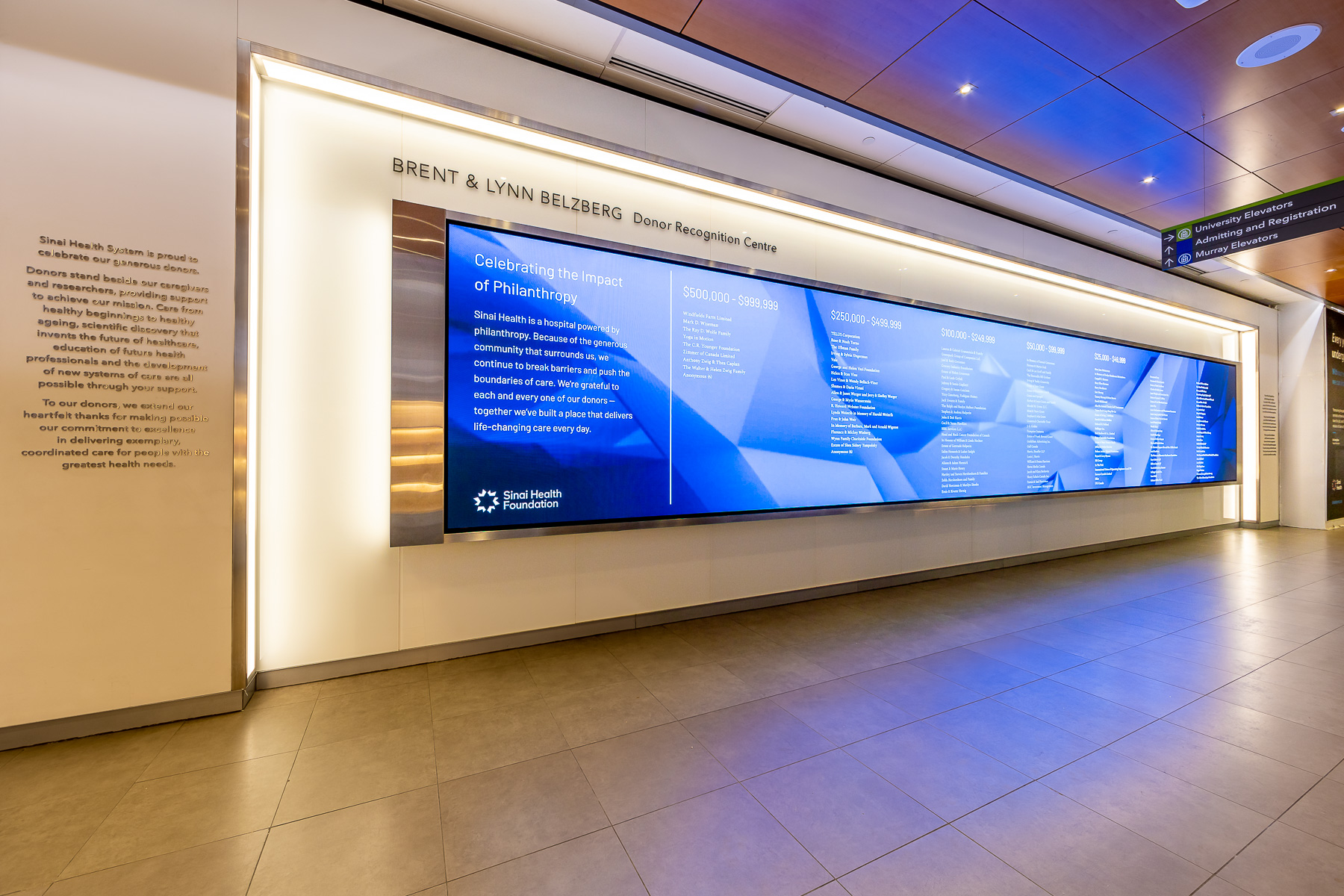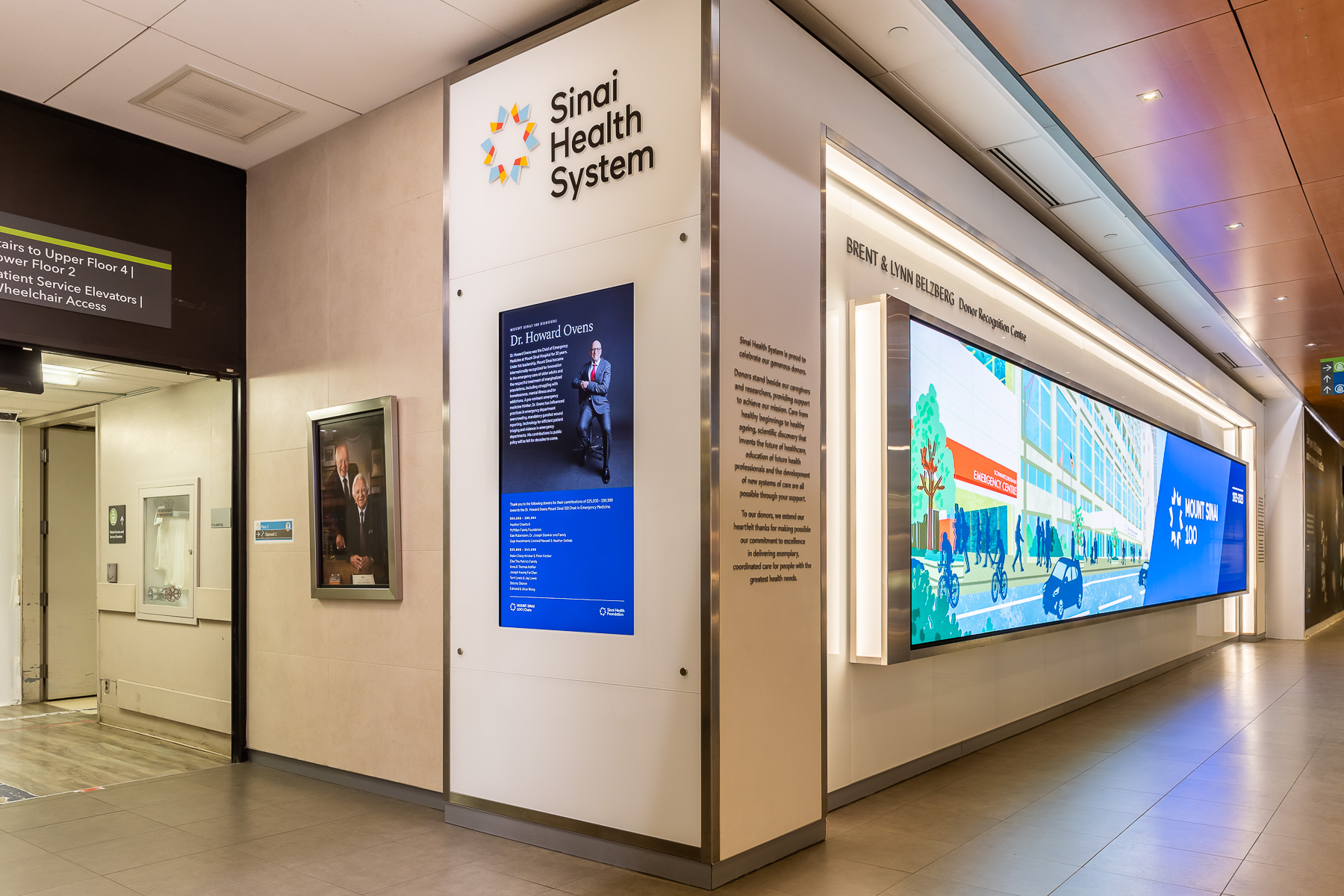A Massive Video Wall Upgrade: From LCD to LED
Learn how this complex retrofit overcame the challenges of working a new display technology into an existing design.

In 2016, a large donor wall built with commercial LCDs was integrated in the Brent & Lynn Belzberg Donor Recognition Centre on the main floor lobby of Toronto’s Mount Sinai Hospital. Installed by Toronto-based design and integration firm Envision, the video wall at that time was the biggest and most complex donor wall in North America, according to Envision chief executive officer Mark Wilson.
“We were seeing a growing need in hospitals for large-scale recognition of significant donations, and Mount Sinai was the first to really have the ambition to do what they did,” Wilson said. “They wanted to make a big and bold statement to the general public and to all of their stakeholders that conveyed how important the culture of philanthropy was to them.”
When the original donor wall was nearing its end of life, the hospital again consulted Envision—this time on a redesign. “The original installation was designed in a way to allow the screens to be updated at a future date, which meant we could retain the majority of the fixture and replace the technology on the inside,” Wilson said. “The client wanted a specific look and feel as well as detailed control of the content management system. That really drove the technology decisions.”
Located in a narrow hallway of the lobby space, the donor wall had always presented challenges from the perspective of viewing angles, Chris Murdy, head of Digital and Innovation at Envision said. “It was a focus of ours to improve the seamless look of the canvas and to reduce the repair surface of the display, which is susceptible to damage from the high amount of foot traffic through the hallway,” he said. “Moving to an LED product, we wanted to specify something where cabinets, modules, or tiles could be easily replaced if need be.”

A Fine Choice
After a careful evaluation of suppliers, Envision recommended a Planar LED solution, which ultimately led to the installation of a nearly 36-foot-wide, 6-foot-high (18x5) Planar MGP Series LED Video Wall with a 1.5mm pixel pitch (MGP1.5).
As a large retrofit, Murdy said the redesigned donor wall was very complex from the perspective of forming a new product into an existing design. “There was also a high expectation of reliability, which required a lot of thought and planning into providing redundancy with power, data, and media playback,” he said. “We worked with Planar engineers to specify the right LED controllers and to ensure we would not have a mismatch with video distribution.”
Murdy added that the project also had a huge requirement to provide the hospital with a much more dynamic tool, allowing them to easily modify the canvas or reformat content. “This was a complete, ground-up reinvention of the experience,” Murdy said. “It was important to establish the future value of this opportunity with the client and ensure they didn’t feel limited by the technology. Planar was a key partner in this regard.”
A daily selection of features, industry news, and analysis for tech managers. Sign up below.
Vince Rozas, director of Design and Production at Sinai Health Foundation, said the new Planar LED video wall—with its multifaceted use and vibrant clarity, and the new content designed by Envision—has completely revamped how the hospital recognizes its many generous donors. “Previously, we were dealing with constraints given the fact that the display wasn’t seamless,” Rozas explained. “It was smaller fonts, inconsistent colors, and things could easily get lost in the seams.”
But following the update, the hospital now has a captivating fine-pitch LED surface to engage audiences, and more flexibility in the way they can present messages, graphics, and videos. They also have more control over managing content. “We are a lot quicker on our feet,” Rozas said. “If we need to react to something or change the content that is displayed, we can do it a lot faster.”
And, while the primary function is donor recognition, the hospital can also use the LED video wall for other purposes such as signature events, communications, large fundraisers, or brand marketing initiatives. “We can plug-and-play anything,” he said. “The animations are clean; the colors much brighter; and visually, the scale of the video wall is really eye-catching,” Rozas said.
“Like so many examples of great design, the new donor wall blends really well within the environment,” Wilson said. “It’s integrated in a way that’s aesthetically pleasing; the video wall is very large in scale, but it doesn’t look oversized. The way LED has transformed the experience is incredible, and most importantly, it provides an impressive canvas for the foundation to recognize its donors.”
The staff of AV Technology serves the community of decision-makers comprising AV/IT technology managers and directors, instructional technologists, and anyone making or influencing AV/IT technology decisions within their respective facilities and institutions.
